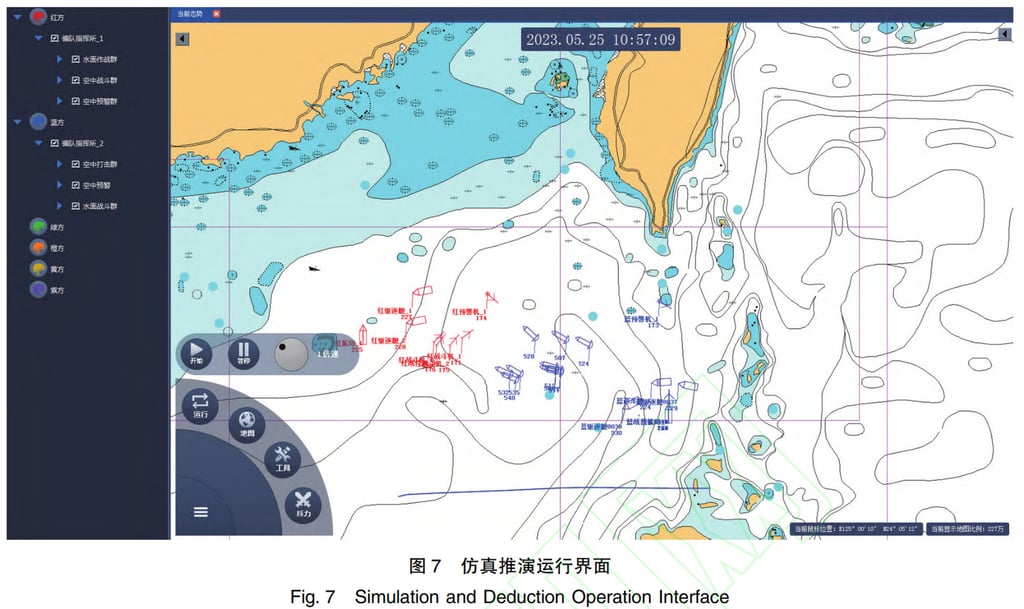Chinese researchers have conducted a detailed simulation of a hypothetical US attack on a People’s Liberation Army (PLA) carrier group in the South China Sea, revealing complex combat scenarios involving the ‘most advanced’ US weaponry.
The simulation, which incorporated key operational parameters of the AGM-158C Long Range Anti-Ship Missiles (LRASMs), offers new insights into potential large-scale naval conflict in the region.
The report, citing Chinese researchers, disclosed that the improved war gaming system accurately modeled the LRASM’s stealth capabilities and operational behavior. This enabled the PLA to refine its countermeasures and tactics against potential threats.
The battlefield in the simulation was set near the Pratas Islands (Dongsha Islands) in the northeastern South China Sea.
The PLA carrier group was stationed near the Chinese mainland, while a US carrier group was positioned beyond the nine-dash line, a boundary Beijing uses to assert its territorial claims.
The scenario envisioned a sudden US offensive, where ten LRASMs were launched simultaneously from various platforms. The missiles targeted a large Chinese destroyer escorting the PLA’s aircraft carrier.

The LRASMs displayed complex operational behavior during the simulated attack. Initially cruising at high altitudes, they descended to just 14 meters above sea level to avoid detection.
The missiles switched to thermal imaging for guidance when they encountered electronic warfare interference that disrupted their radars and GPS signals.
At a critical moment, the missiles executed a surprise maneuver. It rose briefly to confirm its attack locations before diving to strike the Chinese destroyer. The Chinese scientists did not disclose the name of the destroyer.
These sophisticated tactics demonstrated the weapon’s effectiveness and revealed operational details not seen before in PLA simulations.
For Beijing, understanding the capabilities of US weapons like the LRASM is crucial for maintaining its defensive and offensive readiness in the region. Researchers involved in these war games emphasized that understanding adversaries’ strengths is crucial for improving China’s military readiness.
AGM-158C Long Range Anti-Ship Missiles (LRASMs)
The AGM-158C LRASM, often referred to as a “Game Changer,” is one of the US military’s most advanced anti-ship missiles. Known for its stealth capabilities and nearly 1,000-kilometer range, the LRASM poses a major threat to PLA assets in the region.
However, its technical specifications and operational methodologies remain classified. Therefore, the ability of Chinese researchers to simulate such nuanced missile behaviors raises questions about how these operational details were obtained.
The Chinese team asserts that their data was gathered through open-source intelligence and “long-term accumulation.”
In the mid-2000s, the US Navy recognized that its existing anti-ship missile, the Harpoon, was no longer sufficient to address the evolving challenges of modern naval combat.
With the rise of the People’s Liberation Army Navy (PLAN) as a formidable near-peer adversary and an increasingly complex maritime security landscape, the need for a more advanced ship-killing weapon became apparent.

This realization gave birth to the Long Range Anti-Ship Missile (LRASM), a weapon so integral to US military strategy that its presence could determine the outcome of future conflicts at sea.
The LRASM wasn’t developed from scratch but rather as an evolution of earlier missile technologies. Its lineage can be traced back to the AGM-158A Joint Air-to-Surface Standoff Missile (JASSM), introduced by the US Air Force in 2003.
Designed for precision land attacks, the JASSM set a new standard in missile design, combining stealth capabilities with subsonic speed and the ability to navigate terrain at extremely low altitudes.
Equipped with GPS and inertial guidance systems, the JASSM could pinpoint targets even under adverse conditions. Its half-ton warhead is capable of penetrating fortified structures. These features proved so successful that the Pentagon decided to adapt this platform for maritime warfare.
Development of the LRASM began in 2009, with the Pentagon aiming to create a missile tailored for ship-to-ship combat. By 2013, the missile had successfully completed its first test flight, launched from a B-1B Lancer bomber to strike a moving maritime target.
The AGM-158C LRASM was officially adopted as part of the US Navy’s arsenal after additional successful tests. With a range of approximately 575 miles—several times that of the Harpoon—the LRASM can engage targets at distances that place adversary ships at a disadvantage.
It is compatible with the B-1B Lancer and F/A-18E/F Super Hornet. The flight testing of this missile is also currently underway for the F-35 Lightning fighter.
In September 2024, the Pentagon released an image showcasing an F-35 carrying the AGM-158C, highlighting the missile’s potential integration with one of the most advanced fighter jets in the US fleet.
One of the LRASM’s standout features is its ability to identify and strike specific parts of a ship. For instance, it can target critical components like an aircraft carrier’s island structure or focus on specific sides of a vessel.
This capability is particularly important when facing China’s aircraft carriers—Liaoning, Shandong, and Fujian—whose starboard-side elevators are crucial for transferring aircraft between the flight deck and hangar. Disabling these elevators could effectively cripple flight operations.
Despite its groundbreaking capabilities, the LRASM is not the Navy’s sole answer to maritime threats. The Pentagon envisions a multi-pronged approach to naval warfare, leveraging a variety of weapons to overwhelm adversaries.
Surface ships are equipped with the Naval Strike Missile, while submarines carry torpedoes and are slated to deploy the Conventional Prompt Strike hypersonic missile in the near future.
This diversified arsenal would ensure that US forces can present multiple simultaneous threats, increasing the likelihood of success against sophisticated adversary defenses.
- Contact the author at ashishmichel(at)gmail.com
- Follow EurAsian Times on Google News




